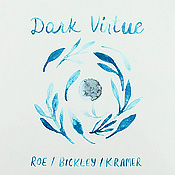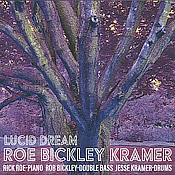Recent Recordings by Area Artists
The piano trio holds a notable place in the history of jazz performance and recording. In days of yore when small clubs could be found in many towns of the land, they often served as the minimal local group and as the rhythm section for touring soloists. In Ann Arbor, the Ron Brooks Trio filled such a role, with a regular weekly gig and hosting numerous traveling musicians over the years at the Bird of Paradise club. For many years the pianist in this group was Rick Roe. The Bird has been gone for almost two decades, but other places have taken over presenting the music downtown in an off and on manner. In 2017 the Ravens’s Club on Main St. initiated a Monday night gig with the cooperative trio of Roe, bassist Rob Bickley, and drummer Jessie Kramer, allowing them to mature as a group and develop an extensive repertoire. While that engagement is no more, the Roe/Bickley/Kramer trio has stayed together playing in various locales and it has just released their third recording, Lucid Dream (LD, Unknown Records), following up on the 2019 Dark Virtue (DV, Unknown Recordings), which somehow escaped SEMJA’s attention, so we make up for it here.

The main difference between the two albums is that while Dark Virtue splits up the repertoire between seven Roe compositions and an equal number of tunes written by others, the most recent CD is more focused on his own melodies, which make up nine of twelve tracks. Both albums are well thought out recitals with excellent flow and contrast between tracks, but the newer one (DV) may have a slight edge precisely because it is focused on Roe’s excellent compositions. This is, of course, a matter of personal taste, but to me these are superior, as jazz improvisation vehicles, to items such as “Reflections,” from a Disney movie, or two tunes by Ivan Lins, who was new to me I will readily admit, but apparently for good reasons (I do not have such a sweet tooth, but I know others will strongly disagree). Having said that, one of the great pleasures here is a rendition of Thelonious Monk’s rarely played “Gallup’s Gallup” on DV. The composer recorded it only once in studio on a Gigi Gryce date; his only other version is preserved on a club recording many years later. Roe is, of course, a master of Monk’s music (his Monk’s Modern Music remains among the top such recitals to date and someone should re-release it). The trio swings this one in a laid-back manner, with Roe showing easy familiarity with this difficult, hence rarely played tune, staying true to Monk’s injunction to improvise on the melody rather than just on the changes. Much the same can be said of “Sweet Sixteen” on LD, another seldom played Monk gem. Among the non-Roe compositions, McCoy Tyner’s “Effendi” also stands out; comparison with the original recording on Tyner’s Inception is instructive. The newer recording seems fresher and digs more into the rhythm, with Kramer providing exciting yet subtle propulsion, which is no mean feat since the drummer on the original album was Elvin Jones.

But in aggregate, both CDs provide insight into Roe’s writing, which displays impressive variety: some tunes as dreamy, for example “Falling Colors;” a wistful “Three Treasures” is followed on LD by the hard swing of “Gelispies’s in Town,” with rhythm patterns in the head providing an apt tribute to drummer Randy Gelispie, then picking up the heat on the Latin-tinged “Agent.” Roe often hangs his tunes on a strong riff rooted in the bass, with angular lines and harmonies that provide good material for development, and the intuitive familiarity acquired in regular performances by the three musicians allows them to take full advantage of this. Bickley has a wonderful clear bass tone, his fleet fingering always precise, with sweet intonation, and a keen musical sense that meshes well with Roe’s love of long-lined melodic exploration. Kramer’s versatility provides the perfect fit: from soft brush to hard stick work and occasionally mallets, he finds just the right rhythms and patterns, driving the band with excitement no matter the tempo, always blending in sonically. Indeed, the primary strength of the trio lies in its interactive unity: this is not a piano trio but an instrumental one, with all three musicians contributing equally, creating a unique collective.
